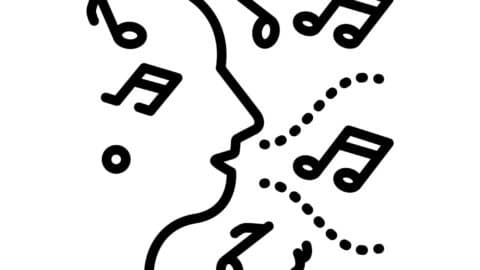An important focus in singing lessons is the vocal sound. We deal intensively with the question: How can we change our mouth space so that we create the best possible resonance depending on the vowel?
It is often underestimated how important it is to train the muscles that are responsible for the formation of consonants. While the resonance of the vowels determines the sound of the voice, the consonants serve clarity and intelligibility. As beautiful as our voice sounds - it is the consonants that distinguish our vocal sounds from each other and make them meaningful words.
When practising vowels, you learn to maintain an even airflow and to muscularly support it. But then, in a song you want to sing, suddenly you hear a tongue twister like: "We can't go on together". What happens to our airflow when consonants are added? What should we pay attention to, and are there any helpful consonant exercises?
The consonants in the oral cavity
When you sing the word "can't", a surprising amount happens in your mouth. First, your tongue, with its placement at the top of the soft palate, briefly blocks the airflow - it is about to form the "k", an unvoiced consonant. Then, with a small explosion of air, the audible "k", your airflow resumes on the vowel "ä". And then, in rapid succession, it is throttled and stopped again: when your tongue passes from the "n" to the voiceless "t". Here you can see a side view of the places in the oral cavity:
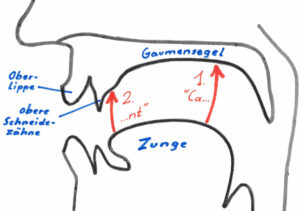
"Singing is extended speech" is a common saying in popular singing. The faster a song is, the closer we come to speaking when we sing. We then don't have time to sing out the vowels for a long time and have to be careful to stay in time. It often helps to be aware of the activity of the lips, tongue and soft palate before singing fast songs.
Here is an overview of the places in the mouth where the lips and tongue produce the most important consonants. The only thing you won't find in the overview is the English pronunciation of the "r", because the longitudinal curling of the tongue is difficult to depict in the lateral view.
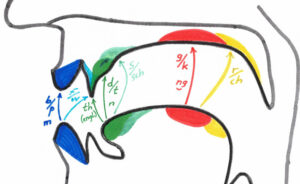
Resting position of the tongue & unnecessary tongue tension
The tongue is the main tool of our articulation. Usually it lies relaxed, like a sleeping animal, gently leaning against the lower incisors. This is its resting position, the so-called "neutral position". It is the starting point for all vowels and consonants.
Try a little two-step test to see if your tongue is relaxed:
- Sit in front of a mirror, open your mouth and let your tongue rest against your lower incisors, as if you were dozing off. Does your tongue look gently rounded and soft, like a pillow, immobile? Beautiful! If it is flat, tense at the sides or moving, then you have unnecessary muscle tension in your tongue.
- Maintain the position, then intonate a "ha" in a speaking voice and hold the tone. If your tongue remains motionless in the same relaxed position against the lower incisors, all is well. If you "have to do something" to hold the tone, that is already too much. The tongue, jaw and throat should not move or tense.
If your tongue develops a strange life of its own during the exercise, loosen it. A classic way to loosen your tongue is to roll it in a circle in front of your incisors, a few times to the right, a few times to the left. This tires the tongue muscles and releases unnecessary tension.
When we sing or speak, our tongue lifts from its resting position. Depending on where we lift our tongue, we produce different vowels. From front to back, these are the vowels: i - e - a - o - u. Check your tongue tension here too:
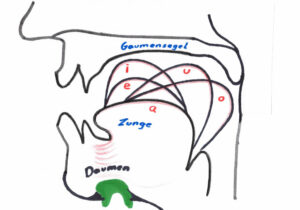
- Place a thumb under your chin, at the base of your tongue, and press gently upwards. When you swallow, you notice how your tongue muscles tense and press against your thumb. We want to avoid this tension of the swallowing muscles as much as possible when singing.
- Now go through all the vowels in a relaxed speaking position, over the main vowels: a - e - o - u - i, with transition vowels. For each vowel, find a tongue position in which you feel no downward pressure on the thumb. Only the last two vowels "u" and "i" require a slight downward tension of the tongue.
Movable against each other: tongue and jaw
Loosening and flexibility exercises for the tongue are important because the muscles of the tongue and jaw are connected to the larynx through their common origin at the hyoid bone.
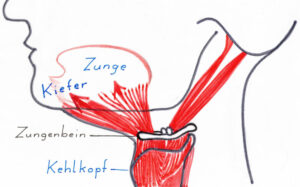
Because of this close muscular connection, tension in one place, for example in the tongue or jaw, can transfer directly to other places, such as the throat. To avoid this, singers must learn to separate the movement of the tongue from the movement of the jaw. Among the many exercises that exist for this purpose, we would like to recommend this one:
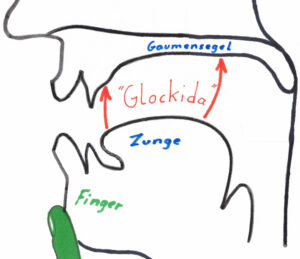
- Open your mouth a finger's breadth, think of something pleasant and go into a mild smile. Put a finger on the front of your chin without applying pressure.
- Sing the word "Glockida" at a fast speaking tempo, in a comfortable voice pitch on the pitches 1-2-3-2-1 (from the root to the third and down again), i.e. five times without your finger moving: your tongue does all the articulation work while your jaw remains motionless.
- Repeat the "Glockida" with the same notes higher and lower. Go as far up and down as you can without "biting", tightening or otherwise moving your chin.
Embedded: consonants in the air stream
Let's think back to the beginning: we sing on a stream of air. It flows like water in a riverbed. Not always with constant strength - the consonants are like constrictions in the riverbed (voiced consonants like "m", "w", "d" or "g") or like boulders on which the water breaks (voiceless ones like "p", "f", "t" or "k"). Despite all the constrictions and rapids, the water flows on, with gentle power.
When singing, see your consonants like this: embedded in your air stream. With their help, you structure the air - instead of pushing air or throwing air forwards with force. The danger here is that you build up too much air pressure when you sing with too hard, violent consonants. Straight in high registers this quickly leads to muscular constriction in the larynx area, your voice is squeezed or even breaks away.
Train the muscles of your tongue in their interaction with the soft palate, lips and teeth so that their movements become precise, effortless and flexible. A "t" or "k" only taps the palate briefly - instead of causing the air to accumulate there and explode forward. An "m" or "b" remains spacious - instead of biting. The tongue always returns to its resting position on the lower incisors.
The exercises suggested above will help you to find a muscularly well-coordinated articulation that always remains embedded in the air. This will help you a lot, especially with fast songs with a lot of lyrics. Then you will no longer stumble over consonants, but the consonants will structure your vocal flow. They rhythmise your sung words, and they even help to bring the resonance of your vowels right to the front.
Rehearsing
Finally, listen to Amy Winehouse with the title "Valery". The song is a beautiful example of rhythmically accented singing in which the consonants play a special role. Winehouse's singing in this studio recording is also well-suited for practicing the "Twangs", a sound that gives our voice more sharpness and carrying power.
You can find good exercises for consonant-vowel connections and for a sustainable vocal sound in my online singing courses, at: https://singasong-behappy.de/online-gesangsunterricht/

